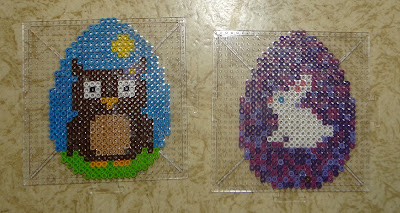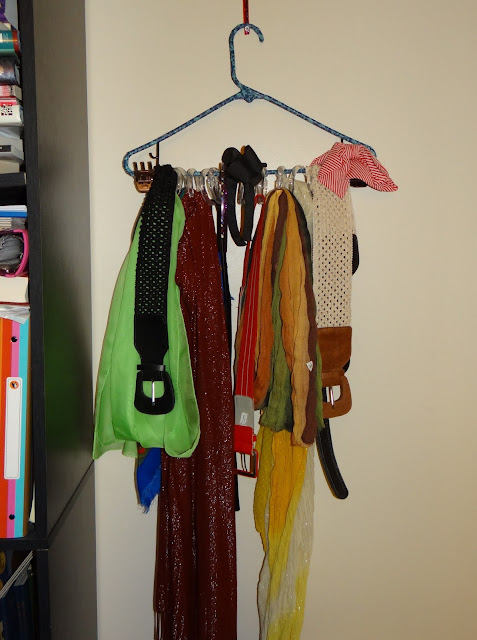Thursday, April 7, 2016
Easy Coasters
I have an odd affinity for coasters. For some reason, having them around makes me feel like a real adult. When I decorated my house for spring this year, I realized that I didn't have any coasters that matched my spring decor, so I decided to make a few. This method is relatively quick, easy, and, if you already have access to a laminator, really inexpensive.
Materials:
*Patterned cardstock
*Thin cardboard, such as from a cereal box
*Double sided tape
*Laminator
*Drinking glass with large rim
*Pencil
*Scissors
Directions:
*Trace around the rim of the drinking glass onto the patterned cardstock and then cut out the resulting circle.
*Note: I used cardboard to make my coasters a bit more robust, but adding the cardboard to the back of the cardstock makes it a little harder to send through the laminator. You can skip the cardboard steps and just laminate cardstock circles if you would prefer.
*Trace circles onto the cardboard as well, one circle for each coaster you intend to make. Cut out the circles.
*Tape the cardstock circles to the cardboard ones.
*Place the circles inside the laminate, keeping plenty of distance between neighboring circles and then laminate following the instructions for your laminator.
*Cut out the laminated circles, leaving a decent amount of laminate around the edges of the circles.
Thursday, March 31, 2016
Mini Checkers Board
*Mini image of a checkers board
*Thin cardboard (e.g. from a cereal box)
*Scissors
*Hole punch
*Cardstock in two different colors
*All purpose adhesive
Directions:
*Print out an image of or construct a mini checkers board, with squares just slightly wider than the size of a circle produced from a hole punch. I took a picture of my butterfly checkers board and then resized and printed it.
*Reinforce the mini checkers board by gluing some thin cardboard to the back.
*Punch out game pieces from cardstock in two different colors. You can either glue the pieces to the game board or leave them unglued so that they can be moved around.
Thursday, March 24, 2016
Mini Colored Pencils
Here's the next installment in my miniseries (pun courtesy of Brian).
Materials:
*Toothpicks
*Box cutter or other reasonably sharp cutting tool
*Emory board or sandpaper
*Full size colored pencils
*Paint
*Paintbrush
Directions:
*Cut a toothpick in half using a box cutter or other cutting implement. Scissors work too, but I didn't like the way they squished the wood around the cut site. The two halves can be used to make two mini colored pencils.
*If the end of the pencil is a bit jagged after cutting, file it down with an Emory board or sandpaper.
*Paint the pencil the color that you would like it to be, leaving the pointed tip unpainted. Set aside to dry. I like painting the whole pencil rather than painting one side and letting it dry, then comping back to paint the other and I found that Perler fuse bead crafts are a good way to handle this. You just paint the toothpick except for both ends and then stick the pointed end in one of the holes in the fuse bead creation. You then carefully paint the end that is now sticking up in the air.
*Once the pencil is dry, color the very tip using a colored pencil. You could also paint the tip, which is what I found I had to do for the white one to get the color to show up.
Thursday, March 17, 2016
Itty Bitty Books
This is roughly the actual size of the mini book I made.
Materials:
*Paperboard or other thin cardboard/heavy paper, such as an old cereal box, heavyweight junk mail, etc.
*Scrapbooking paper with small pattern
*All purpose adhesive
*Scissors
*Pencil
*Ruler
*Plain paper
*Paper to use for mini pages
Directions:
*Decide what size you would like your mini book to be. The first books I made were about 3.5 cm high and a little more than 2 cm wide. Draw two rectangles of the desired dimensions on your paperboard/cardboard to make the front and back covers and another, thinner rectangle to make the spine. Cut out these three pieces.
*Lay out your rectangles on your sheet of scrapbooking paper, with the thin rectangle sandwiched between the two wider rectangles, and a slight gap of space between each piece, as shown below. Glue the three pieces down.
*Cut around the rectangles, leaving about 1/4" or so of space around the edges of the cardboard and then cut off square chunks at the corners, as shown below.
*Cut slits at the top and bottom where the spine of the book is. It's kind of hard to see in the picture below, so if you can't tell exactly what's going on, check out the picture after for further guidance.
*Fold over the overhanging paper at the sides and glue down. Repeat with the pieces of paper at the top, ignoring for the time being the tabs at the spine.
*Glue down the tabs at the spine.
*Cut out rectangles of paper just slightly smaller than the size of the book covers and glue over the inside of the covers.
*Print out mini pages sized to fit in your book. The way I did this was I opened up an old document in Word or Adobe Reader and then changed the view to display two pages at once. I then took a screenshot of the two pages and pasted this into Paint. I moved one of the pages up against the other so that there was no longer a gap between them and then I selected the two pages together and pasted them into Word. I then shrunk them down to fit the book. From here if you're not too concerned about the text you're using, you could just copy and paste the two pages a bunch of times, or you could take screenshots of different pages and repeat the procedure with those pages.
*Print out enough pages to fill your book. This will vary depending on the thickness of the spine. For this one, I used five copies of the stuck together two pages. Cut out pages, leaving them stuck together in groups of two.
*Fold in half along the divide between the two pages.
*Place pages in a stack, gluing together the blank sides as you go.
*Glue along the spine and stick into the hardcover part. Now you have your book! Make a whole bunch of them!
Thursday, March 10, 2016
Perler Fuse Bead Easter Eggs
Celebrate Easter and spring's arrival with these fuse bead Easter eggs. For some fun spring themed fuse bead magnets, check out this post.
Materials:
*Fuse beads (e.g. Perler beads)
*Large square peg board
*Iron
Directions:
Design your fuse bead creations by arranging beads on a peg board, following the patterns given below:
The rainbowy egg is supposed to look like a melted crayon art egg.
I love Easter eggs with faces, so I decided that I had to make one for this craft.
*Cover the designs with a sheet of waxed paper and iron the first side. Make sure to iron the edges especially well, as the beads may not stick together and may fall off if you don't.
*Remove the fuse bead project from its peg board, cover with waxed paper, and iron the other side.
Thursday, March 3, 2016
DIY Doodle Frame
Materials:
*Picture frame
*White spray paint (if frame isn't already white)
*Permanent markers
Directions:
*If your frame isn't already white, paint it white, following the instructions printed on your particular spray paint.
*Once your frame has dried for the requisite amount of time, draw doodles on it with a black permanent marker. I asked my awesome partner Brian, of Maineiac Coloring fame, to draw doodles for me. Aren't they neat? (Note that the red marker is from me. I had already started coloring when I realized that I should probably get a picture of Brian's design.)
*Let the black marker dry for a while. I left mine overnight, but it probably doesn't require that much drying time.
*Once the black marker has dried, color in your designs.
Thursday, February 25, 2016
Easy Accessory Holder
It really doesn't get much easier than this craft. The cost is minimal too. If you're looking for a way to store your accessories, this may just be the craft for you.
Materials:
*Coat hanger
*Shower curtain rings
*Washi tape (optional)
Directions:
*To jazz up a plain coat hanger, wrap in washi tape, if you'd like.
*Clip shower curtain rings around the coat hanger and hang your accessories from these rings. That's it!
*Depending on the weight of your accessories, you may want to use a nail to hold it up, but I've actually gotten by just fine using a thumbtack.
Subscribe to:
Comments (Atom)



















